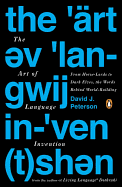
What do Star Trek's Klingon, J.R.R. Tolkien's Elvish and Game of Thrones' Dothraki have in common? They are fully functioning languages constructed by humans for fictional purposes, each imbued with a complex system of sounds, words, grammar and an evolving linguistic history. How these conlangs (constructed languages) came to exist on the page and on both the small and big screens is the topic of linguist and master language creator David J. Peterson's (Living Language Dothraki) book The Art of Language Invention, a layperson's crash course on the science and art of linguistics.
Peterson analyzes and discusses the elements critical to the creation of natural languages--sound structures and syllabaries, words and word units, grammar, language growth and written structure. He uses examples drawn from his own invented conlangs--Irathient (SyFy's Defiance), Shiväisith (Marvel's Thor: The Dark World), Dothraki and Valyrian (HBO's Game of Thrones)--to illustrate important linguistic concepts and provide concrete tools for those interested in pursuing conlang development. Peterson talks about the difficulties inherent in such an endeavor, and discusses the culture of conlangers and the compromises they must make in order to please studio bosses who want something recognizable and pleasing to viewers.
The Art of Language Creation is by no means light reading. While Peterson does an admirable job simplifying linguistic principles for the average Joe, creating a credible, working and breathing language requires the mastery of key fundamentals, and this demands serious study by readers.
"Once you know the science," writes Peterson, "then you can apply your knowledge of language to the being you've created and build on top of it." --Nancy Powell, freelance writer and technical consultant

